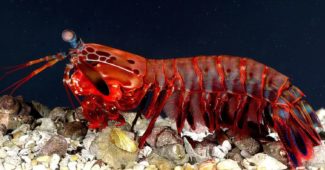Some animals possess a sixth sense that allows them to perceive the world in ways beyond human imagination. These abilities have evolved over millions of years and serve as survival advantages. Although the scientific explanation behind these premonitions remains unknown, experts agree that these animals can sense disasters well before humans would even notice.
Discover the top 10 animals that possess exceptional abilities through their sixth sense.
10Platypus
Did you know that the platypus possesses a unique electromechanical sensory system in its bill? This adaptation enables the platypus to locate its prey in murky waters, even with its eyes closed. The super-sensory organ boasts three receptor cells that help the platypus detect movements and subtle electric fields its prey generates.
One of these cells is the Push-rod mechanoreceptor, which senses changes in pressure and motion. Additionally, two other types of electroreceptors track the electrical signals generated by the muscular contractions of small prey. Also, by moving its head from side to side, the platypus can determine the direction and distance of its prey by combining these sensory inputs.
9Pistol Shrimp
Pistol shrimp have a unique oversized claw that resembles a pistol. This tiny creature uses its claw to create a high-frequency shock wave of bubbles, instantly killing its prey. The shock wave is so powerful that it can even break glass and generate massive heat. Pistol shrimp usually live in colonies, and their shock waves can disrupt underwater communication and sonar.
However, the noise they create can also reflect the health of the coral reef. Lots of hunting by these creatures is a sign of a balanced ecosystem. Additionally, the noise created by pistol shrimp helps other sea creatures to navigate the area.
10 Amazing Animals You Probably Didn’t Know Exist
8Bat
This ability is due to magnetite-based receptors in their brains. Lastly, their polarization vision helps them sense the sun’s pattern in the sky, even on cloudy days or when the sun has set. Bats use this sense in combination with their geomagnetic sense for navigation.
7Pit Viper
Pit vipers have a special organ between their eyes and nose that allows them to sense heat. This unique ability allows them to see infrared rays and detect heat sources, making them skilled hunters even in complete darkness. The organ has an antenna that sends signals to the snake’s brain whenever a warm body is nearby.
These signals help the snake determine the size and shape of the creature that heats its sensor, enabling them to see in infrared or detect heat signals. By having this receptor in a ventilated location, pit vipers can easily sense any changes in temperature, including the delicate temperatures of nearby prey.
6Shark
The small, black spots around a shark’s head are called ampullae of Lorenzini. These jelly-filled sacs contain nerve receptors that conduct electrical impulses induced by muscle contractions of animals in the shark’s environment. As specialized electroreceptor organs, they sense electrical fields produced by animal heartbeats and temperature changes in the water column.
Thus, sharks can locate their prey at a very close range by sensing even the weak electrical fields produced by animals in the ocean. Additionally, the ampullae of Lorenzini can sense the Earth’s electromagnetic field, which helps the shark use it as an internal compass for homing or mass migrations.
5Comb Jellyfish
Comb jellies have unique giant fused cilia plates, also known as combs, that run up and down their bodies. These tiny oars propel the comb jelly through the water. Interestingly, comb jellies are the largest known organisms that use cilia to swim. When the moving cilia scatter light in different directions, their comb rows often produce a beautiful rainbow effect.
Since comb jellies don’t have a central nervous system, they have specialized balance receptors called statocysts that coordinate the movements of their cilia to help them navigate through ocean currents about hundreds of miles. Additionally, the Ocelli photo-receptors allow them to sense light and dark without creating a complex image.
4Pigeon
Additionally, pigeons can detect the strength of the Earth’s gravitational pull. They possess a tool like a gyroscope to differentiate between the gravity at their home and the location they were released. Even when released in unfamiliar locations, carrier pigeons utilize Earth’s magnetism, the stars, and the position of the sun to find their way home.
3Sea Turtle
Some largest species, such as Leatherback Sea turtles, have a pineal gland that appears as a light pink spot on their head, acting as a skylight to provide information about the seasons and influence migration. Researchers believe the magnetotactic bacteria that move in response to the earth’s magnetic fields and form symbiotic relationships with host animals can influence sea turtles’ geomagnetic mechanism.
2Dolphin
In addition, dolphins use echolocation to get a three-dimensional view of their surroundings through sound waves, like how a sonar device works. Thus they locate prey even in regions with limited visibility, like murky rivers or ocean depths without light.
Related Articles
1Spider
This gives spiders a sixth sense to easily judge the size and weight of things in their vicinity, especially the creatures caught in their webs. These sensory organs also help spiders differentiate between the movement of the wind or blade of grass and the movement of an insect. Therefore, spiders can sense even the tiniest strain on their exoskeleton and become aware of any nearby movement.




